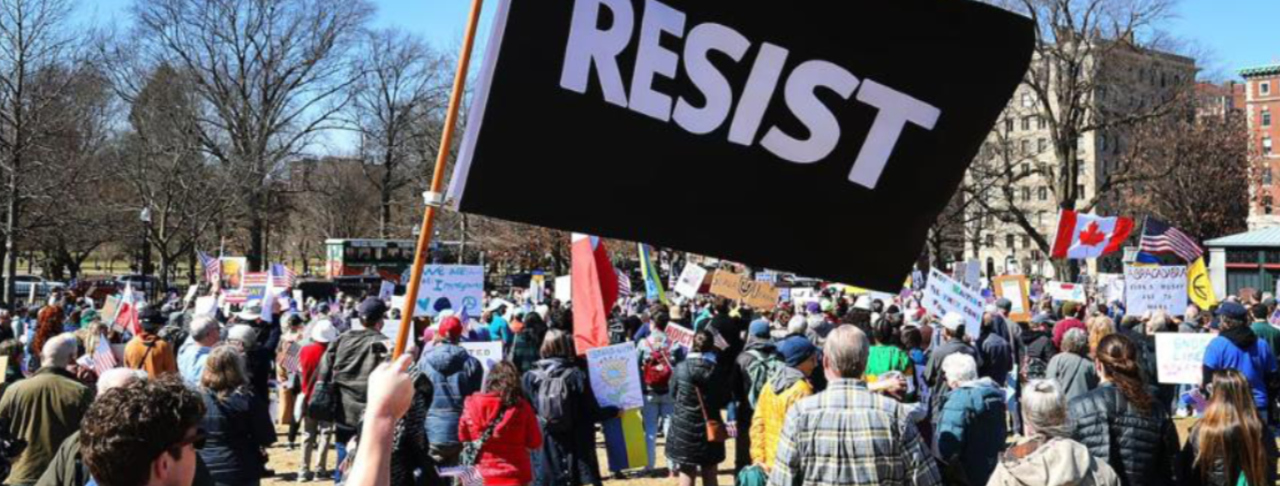the utopian
STOP TRUMP/MUSK! BUILD THE RESISTANCE!
ORGANIZE TOWARD A NATIONAL GENERAL STRIKE!
IN THIS ISSUE…
- Stop Trump/Musk
- Orientation to a Growing Political Movement
- Discussion : Orientation to a Growing Political Movement
- Glimpses of a Growing Movement
- What Is Trump Up To
Draft Leaflet
STOP TRUMP/MUSK!
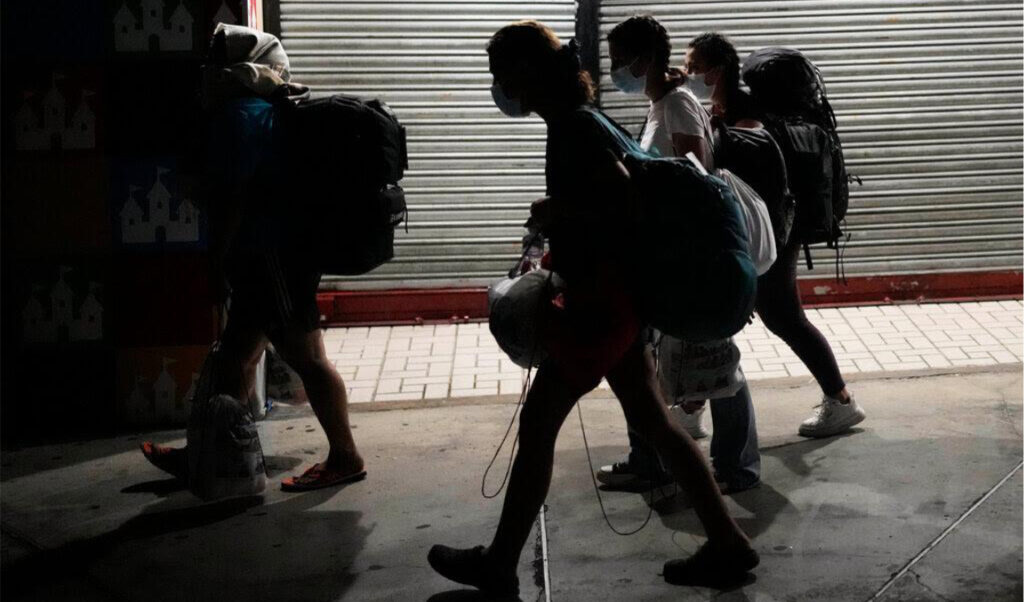
You’re reading the Utopian, so we needn’t tell you that Donald Trump, Elon Musk and their gang have declared war on the needs of people and the planet and will take from us all they can.
This is growing authoritarianism in progress. They claim that Trump’s election is their mandate to do what they want. But Trump did not campaign for most of what he’s doing now. He denied knowledge of Project 2025, but on day one in office signed dozens of executive orders to implement its recommendations to shred the social safety net. Trump did not campaign for the U.S. annexing Canada, nor for taking back the Panama Canal, nor for turning Gaza into a seaside resort after expelling its entire population.
There is no mandate. This is a top-down attempt by authoritarians who threaten to deport or arrest any that disagree.
What will we do to stop the Trump/Musk attack?
Organize: Stand Up, Speak Out, Act Up, Fight Back, Fight Forward!

Build resistance from the ground up—Join or organize local groups
Because Trump and Musk can’t tolerate any disagreement, the most basic but essential way to resist is for as many people as possible to express their disagreement. We urge everyone to stand up and speak out. This can be as minimal as getting together with family, friends, and neighbors.
Local groups can organize forums that might even become town hall meetings. (Many Republican legislators have stopped holding their town hall meetings because of anger about the Trump/Musk policies from their constituents.)
Local groups can provide mutual support and can be nuclei for organizing community and workplace defense in the event of threats from thuggish Trump supporters.
Speak Out, Act Up, Fight Back, Build Towards General Strikes
Whether to local groups, at workplace gatherings, at union meetings, or in one-on-one conversations, we should be speaking out and calling for action. Neighborhood vigils, local rallies and marches, noon time work stoppages—building towards regional and national protests aiming at local, regional and national general strikes to dismiss Musk, dismantle DOGE, and dump Trump.
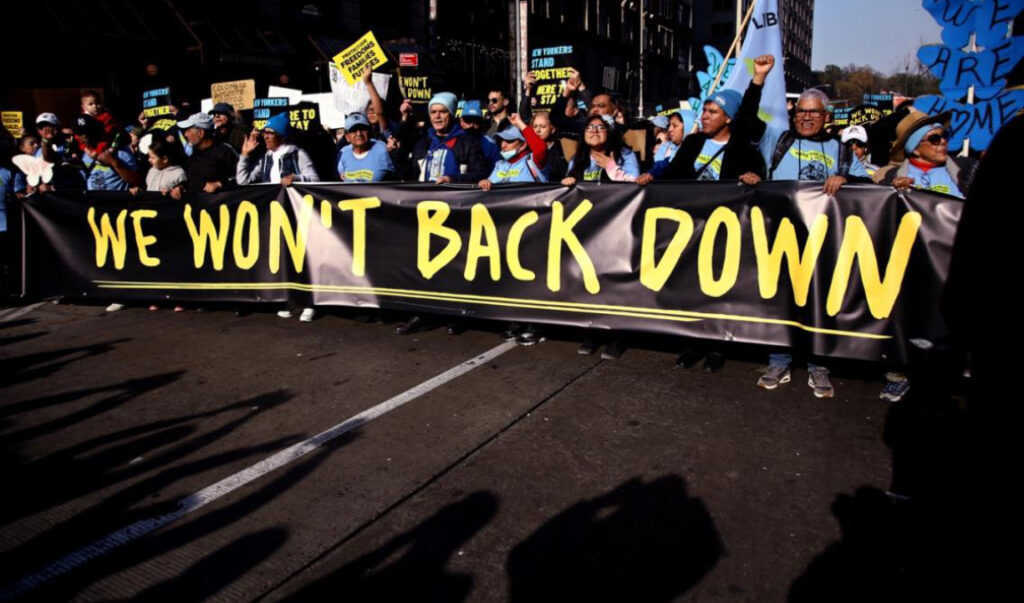
Fight Forward
Local groups and local assemblies can lay the groundwork for reorganizing our society from the ground up. The status quo prior to Trump’s inauguration was unacceptable. A new world is possible, based on cooperation and mutual aid, not profit and greed.
Perspective
Orientation to a Potentially Growing Movement

By Ron Tabor
I believe we are witnessing the beginnings of a mass movement against Donald Trump, his administration, and his policies. As of now and in terms of demonstrations and other actions, this movement is still small. But the emerging movement has the potential to grow in the coming weeks and months, especially as the results of Donald Trump’s actions and policies become clear. Rather than “make America great again,” Trump’s plan for the country is likely to cause a great deal of damage, up to and including provoking a global recession and perhaps even launching a world war. The emerging movement has the potential to be extremely broad, including the very poor (undocumented workers, DACA people, and recipients of government programs), organized workers (including laid off auto and steel workers), members of the middle classes (including government workers, educators, scientists, and those working in the medical fields), and even members of the upper class/ruling elite. It may also become very militant. In 2017, the “Resistance” to Donald Trump blossomed almost from the day of Trump’s inauguration, from the Women’s March and the March for Science to the actions at the country’s airports against Trump’s Muslim travel ban. This time, for a variety of reasons, it has developed more slowly. But, both in terms of size and militancy, it may well reach the level of the movement in 2017, if not higher. Of course, I may be wrong, but I think for a group like ours, it would be a big mistake to assume the current struggles are not going to grow in size and strength.
I believe we should begin developing a revolutionary strategy to address this movement. True, our group is very small and has little influence on anything, even our own friends and family members. However, we do know a lot of people, including many who have been, are, or may soon become, active in the movement. We also have a great deal of experience. Although much of it is from many years (decades?) ago, there are some facets of mass social and political movements that have remained consistent for epochs. (For example, I believe there are still things we can learn from the French Revolution, and the many revolutionary upheavals since then.) Although it might not seem as if we may be able to influence the movement, one never knows. And, even if it is only out of habit, I believe we should try.
Aside from supporting and, where we can, participating in the developing struggle, there are two things I would like to emphasize as we begin to think about our position:
- On the strategic level, as we seek to unite with people in struggle, we also need to think about promoting our own, revolutionary, program. It is overwhelmingly likely that, however militant some facets of the movement may be, politically, the overwhelming majority of the movement will be moderate, even conservative. By ‘conservative,’ I do not mean that it will adopt the politics of the contemporary conservative movement. I mean the term ‘conservative’ in a much broader and more general sense. Since so much of Trump’s program, and personality, is destructive, the fundamental aim of much, even the majority, of the movement, particularly its middle- and upper-class participants, will likely be defensive, even restorative, that is, to defend the current system from Trump’s perceived attack on it. For example, many if not most people in the movement will be motivated to defend “American democracy,” the constitution, the federal government, and the other institutions of US imperialism, such as NATO and USAID. Since we are revolutionaries who aim to replace the current system, including the constitution, with a better, more democratic and more just one, and since we are opponents of US imperialism not supporters of it, we should not uncritically support such an approach. We should certainly defend democracy in the broadest sense from Trump’s (and anybody else’s) attacks on it, but we are certainly not defenders of the US constitution, or the current institutions mandated by it. In fact, our goal is not to defend them but to overthrow them. We therefore need to look for ways to differentiate our revolutionary goal from the reformist aims of the Democrats, the anti-Trump Republicans, and the reformist and authoritarian leftist organizations, who will seek to assert their hegemony over the movement.
- On the tactical level, we should seek to unite people in struggle, not divide them. Failing to do this has been one of the fundamental flaws of the contemporary left in the recent period. For example, while we fight for the rights of the various oppressed “identity” groups (e.g., Blacks, Latinos, Native Americans, women, LGBTQ+ people), we do not set such groups against each other, competing for pieces of the pie; nor do we insist on the rights of those people at the expense of the rights of people the left has demonized as “oppressors,” (e.g., whites, Asians, Jews, males, straight people). Thus, in militant contrast to the tactics of the Black Lives Matter Movement, which rejected the slogan “All Lives Matter,” we emphasize that slogan as the basis for the movement we are attempting to build. All Lives Matter—in the broadest sense, that is the substance of our program.

In the same vein, we should firmly reject the notion that the trashing of small and medium-sized businesses, let alone people’s residences, is a viable tactic in the struggle. The movement we aim to build should actively embrace as many people in our society as possible and not demonize, a priori, some social groups as being inherently reactionary or not worth reaching.
Please post your thoughts.
—Ron
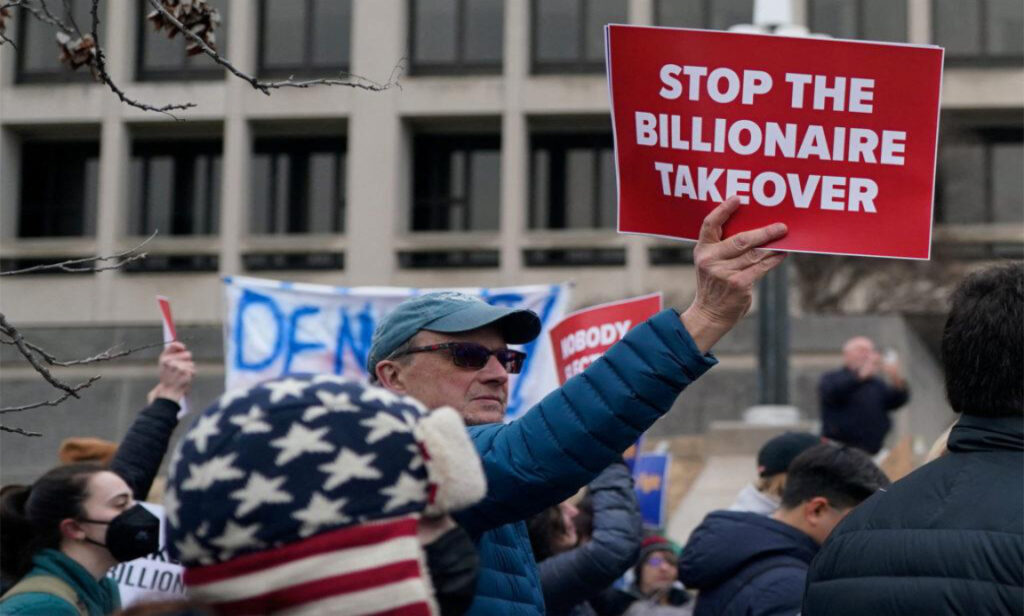
Utopian Tendency Discussion
Orientation to a Potentially Growing Movement

I very much agree with what Ron has put forward.
I agree that it’s very important to be clear that we are not champions of the old status quo—the Deep State, the inertia, corruption and bureaucratic waste, etc. We’re against attacks on democratic rights and on services that everyday people depend upon, but we want to fight for something very different.
I also agree that it is important to posit the need for unified struggle in contrast to the divisive and dictatorial identity politics and political correctness.
One more point. It’s likely that the movement will develop gradually in both size and substance, at least for the next few months. But if past experience is any guide, then a rapid and turbulent growth can occur suddenly and seemingly out of nowhere. Consciousness does not necessarily grow linearly. Just a few examples : we saw this in 1968; we saw it in 2011 with Occupy; we saw it six years ago in the Red State teacher strikes. This should be factored into our strategy.
I will try to say more in future posts. Right now, though, I would like to know what others think.
—Jack
Thanks, Ron and Jack, for posing these vital strategic and tactical issues. (I’ve been growing tired of reading links to articles posted in this group that, in the main, recapitulate what we already know, but without any direction toward meaningful actions.) I too think the resistance movement will continue to grow, at least slowly but steadily, and perhaps reach a tipping point of a more massive explosion of consciousness.
I’m interested in knowing what Ron thinks the relevant lessons from the French Revolution are, etc., that might speak to the current situation.
Ron writes in point 1: “ We therefore need to look for ways to differentiate our (revolutionary) goal from the (reformist) aims of the Democrats, the anti-Trump Republicans, and the reformist and authoritarian leftist organizations, who will seek to assert their hegemony over the movement.”
Ah, but ‘how?’—we of little influence? Point 2 is, in my opinion, indisputable.
As for terrible tactics, I would add to “[not] trashing… small and medium-sized businesses, let alone people’s residences”, the stupid tactic of occupying highways and bridges for hours on end – preventing ordinary people from showing up at work, getting to medical appointments, picking up relatives, etc., etc. So counterproductive if you want to win hearts and minds to your cause!
—SPM
I agree with Ron’s approach and Jacks comments. I have a couple of quick thoughts.
First is the need to fight for the political independence of any movement. Right now, I think there is a kind of equal and opposite reaction to Trump’s ‘flood the zone’ attacks, with the focus being against Trump (Musk) rather than the specific damages. Trump’s attacks inevitably will inflict damage on his own supporters. Uniting them with others will be that much more difficult if the main focus is on the person they voted for. Therefore, I think it’s important to emphasize unified collective struggle against (fill in the blank) attack rather than a generalized ‘Down with Trump’ approach (and up with whatever mangy dog the Democrats can pull out of the yard).
Second, I think any emerging resistance will be quite diverse. In that sense I question whether it’s worth making ALM a central slogan which inevitably will invite various opportunists out of office to counterpose BLM to divide the movement. Better Peoples’ Lives Matter? People First?
—Bill
I thank Ron for his statement. I agree with the observations and points made. I also appreciate those made by Jack, Page and Bill. In addition to any formally general statement of position or specific takes on aspects of the Trump/MAGA offensive we may work up for the website , it would be good at some point to hit some budding movement activities with leaflets issued over our web address.
Not to get ahead of ourselves (myself), I look forward to elaborating a clear (revolutionary) viewpoint, not one in effect in the camp of Democratic Party restoration through this discussion. I likewise want to push an approach that stresses the need to build a movement inclusive in spirit and intelligent in its application of militancy. One that avoids many of the flawed notions driving (and dissipating) BLM, Antifa and Palestine solidarity of the recent past.
I strongly support a movement not confined in its perspectives to a progressive, liberal and left activism and mindset.
—Mike E.
I thank Jack, Page, Bill, and Mike for their thoughts.
As to Page’s comment about how we might influence the broader movement, since there are so few of us (we are old, our politics are far from the mainstream, we are not on social media, etc., etc.), I think we should act on the possibility, however much of a longshot it may be, that what we have to say might reach and strike a chord with other people and groups. As I wrote, we know a large number of people, have lots of experience and a good deal of knowledge. Besides, does anybody have a better idea of what we ought to do? We believe a movement is emerging, why not try to influence it as best we can?

In regard to Bill’s comments about the All Lives Matter slogan, I’m not worried about what some opportunists may say or do. The BLM leadership had their shot and made a mess of things, including, in my opinion, helping Trump get elected (although they did make a lot of money). Certainly, as far as substance is concerned, in the broadest sense “All Lives Matter” is the foundation of our program and vision. Why hide that?
I very much agree with Page’s criticism of the tactic of blocking freeways (and other mass transit venues) at rush hour (or at any other time). How not to win friends and influence people! Especially since most of the people on the roads are working class and middle- class people going about their business. But such tactics are typical of the left’s authoritarianism. Rather than trying to convince people of their views through careful and thoughtful arguments, the left seeks to coerce people into submitting to them. We’ve seen this throughout the entire past period, from shouting down speakers who disagree with them on college campuses and elsewhere, to getting people fired (“cancelled”) from their jobs for their “incorrect” views, to brainwashing teachers, staff members, and students in the schools and workers in workplaces through compulsory DEI workshops and “professional development” sessions, to establishing “no Zionist zones” on college campuses (let along offering enthusiastic support to Hamas!), to trashing small and medium-sized businesses and physically assaulting people, to writing off all Trump supporters as ignoramuses, racists, and Nazis. Coercion is the theme that runs through the entirety of the left’s strategy and tactics. As this shows, the overwhelming majority of the left today is totalitarian. Their goal is the establishment of a society entirely controlled by the state. They call it socialism. That’s not what we want. In contrast to the left, our aim is to persuade people of our ideas. How can it be otherwise when our ultimate goal is to create a truly democratic (and egalitarian and just) society? To establish and maintain such a society means being able to have discussions with people we disagree with on the full range of social issues. It is not about forging a “revolutionary” minority that aims to crush all opposition through repression and violence.
This, to me, is one of the chief lessons of the French Revolution. In its aftermath, the majority of the left sought to emulate the French Jacobins, that is, to set up a centralized dictatorship to impose its revolutionary program on the rest (indeed, the majority) of society, particularly the peasants. Instead of centralism, which is the fundamental organizational principle of Marxism and Leninism, we should stress decentralism and local autonomy, the fullest extension of democracy. The only political trend that sought a different, a non- statist, approach were the anarchists, yet the majority of today’s anarchists are as totalitarian (and as stupid) as the rest of the left.
—Ron
A few comments:
First, as to whether we can influence a broader movement. I have found that when one is able to stand up and speak truth to power, some of the time some folks will be listening. Especially in uncertain times, there will be good people open to listening, discussing, and acting. When I returned to political activism after a long hiatus, at the age of 63, this was how I was able to play significant roles in the 2009-10 March 4 movement to fight cuts to education in California; the spring Oakland campaign to bail out schools not banks and stop home foreclosures; and the 2011-12 occupy Oakland education committee (culminating in an 18 day sit in at Oakland’s Lakeview Elementary). I know that my experience wasn’t unique: Mike E. played major roles in anti-racist, anti-fascist, and workplace organizing, for example. Bill could say a lot about what he’s done.
I don’t expect to be able to play the same kind of activist role now, but I’m talking to people I know, some of whom want to talk about what can be done and on what basis.
This leads me to the question of freeway occupation, which Page brought up first here. I have always thought that it’s a dumb tactic, one that’s bound to antagonize and divide. Ditto trashing small businesses, overturning trash cans in residential area, smashing car windows and the various other ways that the black block and co- thinkers act out and alienate. Where I have been in a position to actively discourage this stuff, I have.
—Jack
I join Jack, Bill, Page and Mike in supporting Ron’s views on the possibly developing ‘movement in the streets’ and our orientation to it.
Below are specific points of agreement, with some annotations or questions.
- We are all in agreement that a movement seems to be developing yet developing slowly. We also agree that Trump’s blatant attacks on wide swaths of people, which will likely continue—even deepen—have a very good chance of sparking a wider and more militant movement. It appears to me that the protests so far are made up, overwhelmingly, of middle-class progressives. A meaningful movement will need to draw in/involve a deeper (and of course wider) base. It would be good if those of us who have evidence of such developments shared specifics. (Bill has mentioned the postal workers, though in a somewhat different context. Jack has provided characterizations of Bay Area protests.)
- We also seem to agree that one of the significant dangers to this movement that many who will say ‘Stop Trump,’ will wind up effectively supporting the reconstruction of the tools of domestic repression and US imperialist aggression. It is my observation that this embrace may include many people who once would have been ardent opponents of FBI, CIA, etc., but have now lost their way. To the degree that this is true, it underlines the size-able educational task at hand.
- On the role of the Democratic Party: It is worth observing that in the 1930, the mass sit-down strikes, and the formation of the CIO, took place with the Democratic Party in power. The Democrats were a limited friend and often acted as significant obstacles. In the 1960s, the Democratic Party owned the War in Vietnam (and in some ways originated it, if one examines the JFK/LBJ actions vs. those of Eisenhower.) Thus, for most of the 1960s, the Democratic Party was the ‘enemy,’ not the friend (‘Hey, hey, hey, LBJ, how many kids did you kill today?’)
A similar, though slightly different dynamic existed with Civil Rights Movement. Though the overall strategy was to pressure the Democrats to make good on enforcing existing laws (14th and 15th Amendments) and to adopt new anti-Jim Crow laws, the movement pursued this largely through militant, mass protest: Montgomery Bus Boycott, 1956-57; Central High/Little Rock, AK, 1957; the Lunch Counter Sit-ins, 1960/61; the Freedom Rides, 1960-61; the desegregation protests in Birmingham, 1963; the March on Washington, 1963; Mississippi Freedom Summer/Mississippi Freedom Democratic Party, 1964; and the 1965 Selma campaign for voting right actions. There were additional protests and campaigns organized by CORE, the SCLC, SNCC, and the Black Panther Party, some intertwined in the above events, but not limited to them. Whatever sympathy the Kennedy brothers and northern Democrats may have shown to civil rights protesters, in practice, they opposed virtually every campaigns, arguing that the leaders were moving ‘too fast’ (hence ‘Letter from. Birmingham Jail,’ 1963). The reality was that the DP feared the loss of its segregationist ‘solid South’ wing that was crucial to Democratic Party national electoral victories.
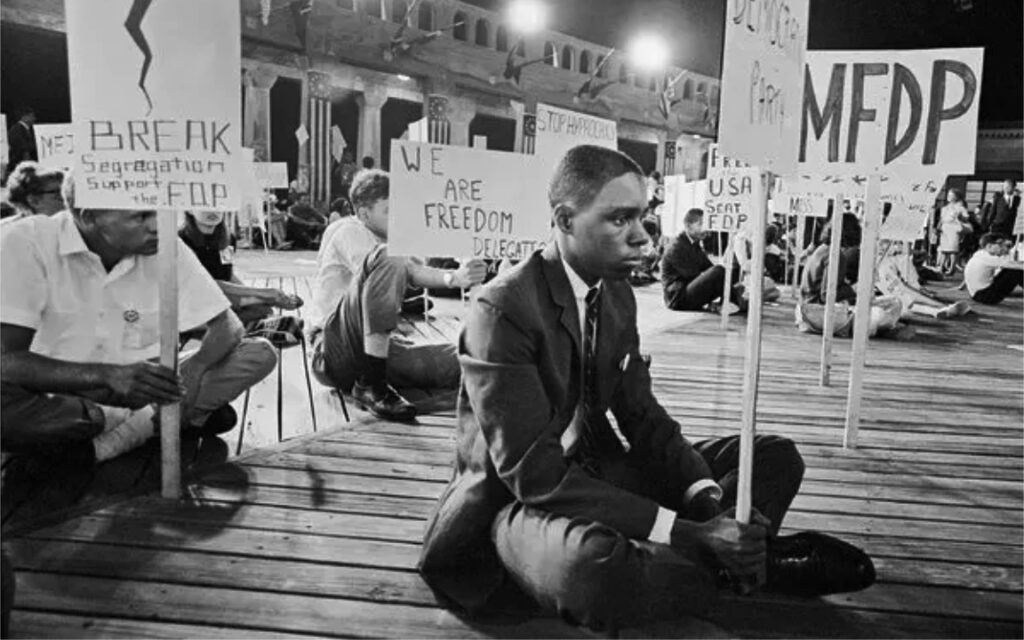
Why this discussion? I think it is important to note that today’s situation presents a very different scenario. The Democratic Party is out of power, particularly regarding its position as the overseer of globalization and related policies that enriched its upper middle class and elite base while leaving its traditional middle class, working class and poor supporters in relative ruins. The DP is now lost in the wilderness: on the one hand, not fully willing to break free of its identity-politics/political correctness stance, while at the same time operating in abject fear of Trump.
The development of a ‘movement in the streets’ will advance the anti-Trump/Musk struggle—but we can count on the fact that the Democratic Party will be there to attempt to channel such a movement into non-militant actions, milquetoast reforms, and pro-Democratic Party electoral activity. This is arguably the most significant danger that this new movement, should it come into being, will encounter.
—Rod
I think that Rod is right to spend the time that he did on the development of past movements and, especially, in the role the Democratic Party will likely play as crisis deepens and mass movement develops. I think that labor leaders will play a particularly insidious role in trying to co-opt and blunt struggle. And it’s important to recognize that NGOs—overwhelmingly, with perhaps a few exceptions—will play a similar role.
The labor leaders and the NGOs, though they may dress it up, will push for restoring the old status quo “enlightened” state and globalist neoliberalism. I agree with Rod (and with Ron) that we need to oppose that and counterpose to it.
On the slogan of “All Lives Matter” or alternatives, I lean a bit towards Bill’s approach. I don’t think that we need try to initiate a ” Lives Matter” slogan right now. I’d prefer to get away from that towards things like “People’s needs, not profit and greed.”
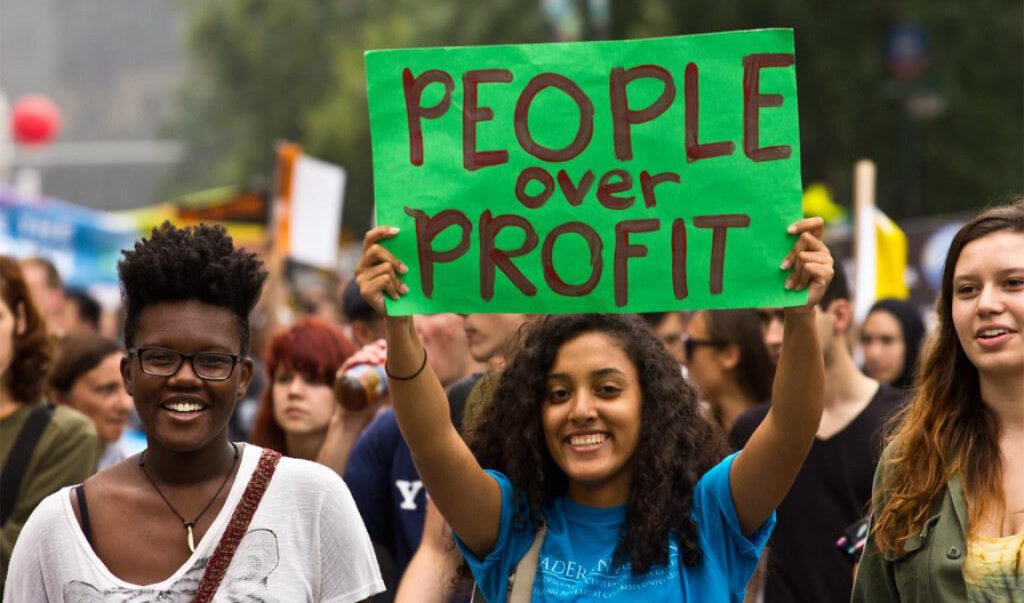
(To be clear, I am not for the “Black Lives Matter” slogan. Four years ago, I preferred “Because all lives matter, black lives matter”—that was called enabling white supremacy by the ‘wokest’ tribunes.)
—Jack
I suggest continuing to discuss what we should do about the emerging movement. Here are some more of my thoughts.
I. On the level of strategy :
- We should think about popularizing the idea of organizing one-day general strikes, in given cities, regions, and nationally. As far as the movement is concerned, this is way down the road, but there’s no reason why we can’t start raising the notion right now, as something the movement may aim for, something that goes beyond picket lines, demonstrations, and small-scale civil disobedience.
- In a similar vein, we should consider the question of calling for a national people’s congress (constitutional convention, constituent assembly). Over the years, there have been calls to eliminate the Electoral College, through which presidential candidates who lose the popular vote manage to win the presidency, e.g., Donald Trump in 2016; George W. Bush in 2000. The Electoral College is only one of the many undemocratic features of the US constitution. (Others are the Senate and the Supreme Court.) I suspect the issue of the Electoral College (and perhaps other undemocratic facets of the current political system) will be raised if/as the current struggle intensifies. Do we wish to raise a call for a national convention to revise the constitution and/or to support such a call if it is raised by other people? The question of a constitutional convention (constituent assembly) has a left salient trail through the history of the epoch of revolutions, from the French to the Russian. (The Bolsheviks, after having called for a constituent assembly as a key part of their program for years, organized elections to such a body after they seized state power in October 1917, then dispersed it after it assembled for just one day when, having failed to win a majority of the delegates, the assembly refused to approve the Bolsheviks’ seizure of power.) Do we, today, support the call for a constituent assembly?
II. Organizational :
- We need to write a new Who We Are Statement, that couches our program in the context of the current crisis in the country. (Any volunteers?)
- We should consider organizing an in-person meeting sometime soon. However, I would only support the idea of having such a meeting if we can guarantee that some additional people, beyond our current list, were likely to attend.
—Ron
I enthusiastically endorse the thrust and content of Ron’s 2 points. Little else to say at the moment but look forward to discussions on our part fleshing out such an approach. I also pray that future events afford us opportunities to engage in agitation and education on some scale. I have couple of things bouncing about I’ll put into a post tomorrow.
—Mike E.
On the larger question of how rapidly things are developing, I’m on the cautious side. But there is no point in debating such matters, we will have to see how they play out.
On the points by Mike that Rod singles out, I agree on no future with Republicans/Democrats and the “neither left nor right” idea, which I’ve always been for. I like “social justice and freedom” as a slogan point and prefer it to “all lives matter.” “All lives” comes across as a counterposition to “black lives matter,” and I think most people hear the latter as a positive assertion of racial justice, not as excluding others. Last, I agree with Mike’s “it’s time that independent free-thinking women and men step forward.”
—Chris
I support Ron’s proposal. I have some ideas about ways to apply this approach locally, and even agitationally, for example, in some places it may be possible to soon start calling for community meetings / town halls / local general assemblies which would help concretize the idea of a national constituent assembly. Also, it may be possible to start popularizing slogans like “no business as usual”, leading to calls for “days of action”, work stoppages and other job actions. These can flow into and point towards general strikes. There are lessons we can learn—positive and negative lesson—from Occupy and other recent struggles.
More soon, I hope, on this as well as on how to raise the defense of democratic rights and people’s needs while making clear that we don’t just want a return to the status quo, domestically or internationally—in contrast to the reformists who will be pushing that (the liberal/labor Democratic Party coalition, including Bernie Sanders, AOC, Robert Reich, labor and NGO leaders.
—Jack
In setting the groundwork for intervening along the lines Ron has laid out folks pause over and give some thought to Jack’s last post on this thread. Hopefully down the road a bit we face a growing movement that we are prepared to address (whatever our limitations in size etc.) on bigger questions of coherence and direction. Presently there are signs of bigger things being possible. To hone our language, position ourselves and have a feel for the players, character and composition of developing events we need to devote time to the present stage. Observations, reports from our respective situations and locales are needed. If there is a past connection to an involved person or formation or an unforeseen opening take a measured stab at it.
By midweek I’ll post up some kind of initial Detroit area report along with any other comments I may have.
—Mike E.
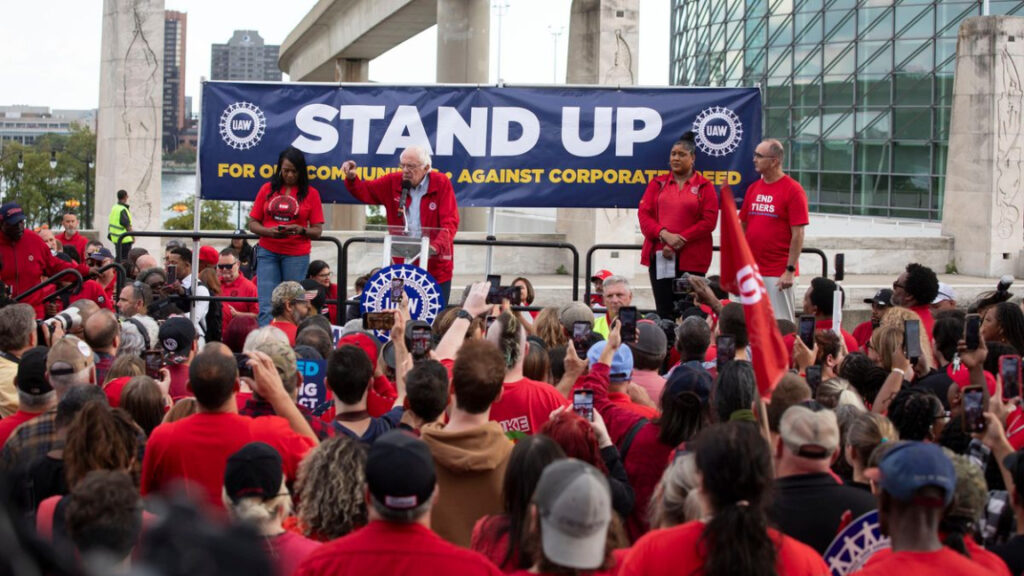
Glimpses of a Growing Movement
News From Detroit
- Tariffs and Auto : No surprise that for weeks the tariffs to be directed at Canadian and Mexican products have been a big story here. The most visible agitation with and against Trump has been out of Canada. Being a borderland with shared media we get more than an ample opportunity to view the Canadian response. This runs from Trudeau’s remarks and across that nation’s political spectrum. Trump’s suggestion that Canada surrender its sovereignty and repeated accusations that Canada de facto collaborates with the Mexican cartels in pushing fentanyl into the US coupled with trade war demands has provoked a rise in Canadian nationalism extending to sport and song.
- Of a differing nature the Ontario Provincial government has been funding a steady campaign of well-made TV commercials on US TV stations. These underline the deep economic and cultural ties between the 2 nations. In particular the fact that 12 of the 50 States engage in significant amounts of shared economy with the Province of Ontario alone.
- For a stretch representatives of the North American auto industry (very and first-hand aware of the fact they are an integrated North American industry) have energetically engaged in organizing against tariffs in the business, governmental and media milieus of importance to them. These reps encompass basic auto, the many tiers of parts supply, dealerships and institutions devoted to development of all aspects of the ground transportation industry.
- The union responses both bureaucratic and rank and file, are bound up in variants of nationalism, each reflective of the specific pieces of the pie in which they are situated. Support for Trump and the MAGA concept (I won’t say program because it doesn’t rise to that level) is big. For example, I cite a non-leftist Black women activist supporter of the present left reformist grouping in UAW leadership. In her department at Warren (Dodge) Truck Assembly she put support for Trump going into November at 40 plus percent. I felt no need to look at long standing Auto Workers for Trump and allied in plant social media sites for their attitude towards Trump’s position.

- The UAW International President Fain is a Christian socialist from Kokomo Indiana and heir to a tradition of Indiana, eastern Kentucky and Tennessee pro-union preachers shaped in and around the UMW and CIO. Of his immediate staff political aides, one is a DSAer who used to work at Labor Notes NYC office. The other comes out of the Michigan anarchist and Anti- Racist Action circles I was active in. Around the UAW’s recent wave of rolling strikes Fain was constantly lambasting Trump as a scab. Scab ! and Eat the Rich ! sloganeering carried over to his high-profile support for Kamala Harris. The Trump machine and Auto Workers for Trump slams Fain for this support and sinking union money into Harris and the Dems. Now there are direct elections in the UAW. I believe the next round to determine who governs the UAW may be just a year away but don’t hold me to that.
- Weeks back, in the wake of Trump’s initial trade war threats directed at Mexico and Canada, the UAW issued a very low-profile comment, reluctant in tone that it would not rule out working with Trump if he takes real action defending workers from unfair trade practices. Last night’s local TV news featured a sharper UAW statement of support for tariffs being used as leverage in plant and product assignment .Just before sitting down to post this I tried to find this latest framing of the union’s position with no success. It was a quick look about but included the union’s central website. Trump’s most recent temporary tariff reprieve and specific demand to the auto execs is for their firms to commit to future plant construction within and product shift to the US to gain extended exemption. The UAW/ labor left’s long standing left populist but nationalist outlook is finding itself overshadowed and boxed in by MAGA’s right version.
- Canadian auto workers since the 80s secession from the UAW and now a large component of the UNIFOR union is comfortable in their respective nationalist worker mindset. Years back as the Big 3 and UAW emerged from the industry’s long lows some amount of Michigan and other US regrowth in plant and employment was a gathering in of infrastructure and product assignment at Canadian worker expense.
- The threat of tariff action targeting Canadian aluminum and steel has put the United Steel Workers of America in the anti-Trump camp. Unlike the wayback US / Canadian parting of ways in the UAW the USWA remains a cross border North American union with a significant Canadian presence. Things revert to a US nationalist outlook this side of the border when foreign ownership issues arise.
- All this noted, the UAW leadership continues to contribute funds to various anti-MAGA challenges, but more or less on the down low. As the effects the Trump administration’s actions take deeper effect and resistance grows, the above described sectoral/regional log jams may begin to break up.
I will try and get a post on the Detroit area’s developments not tied to tariffs and one industry.
—Mike E.
More From Detroit
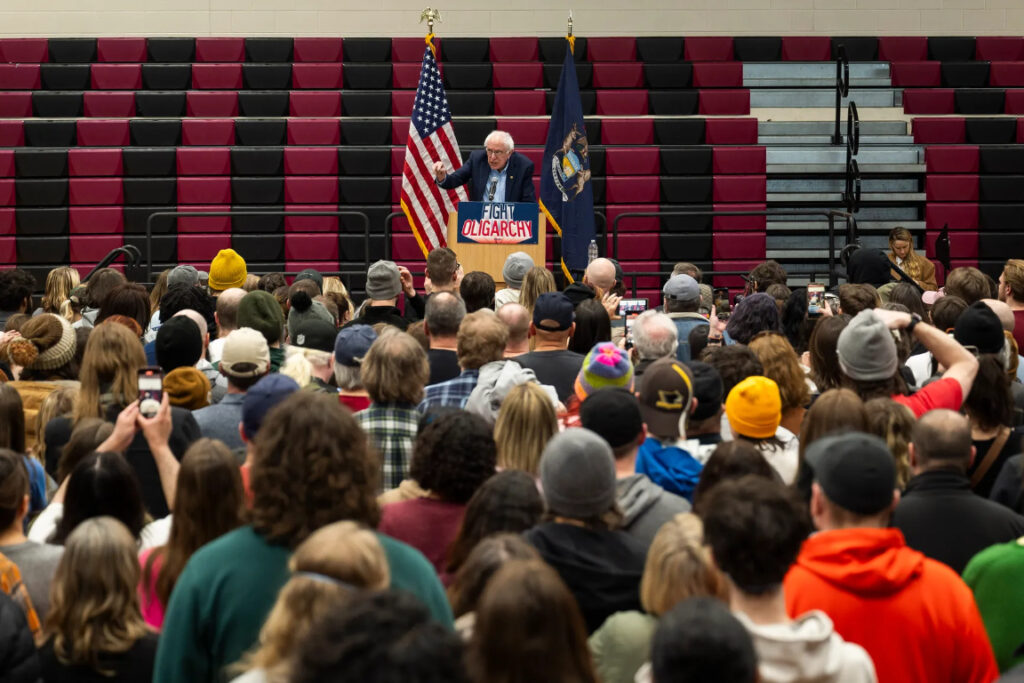
Here is some further reportage of response in the Detroit area to the first weeks of Trump.
Last night saw the largest reaction to date with 10,000 turning out for a Bernie Sanders “Fight Oligarchy” rally in Warren, Michigan. Warren a Detroit suburb and Michigan’s 3rd largest city is a major hub for both General Motors, Stellantis (Chrysler) and many component supplier operations. The city also hosts a significant number of federal civilian employees attached to the US Army’s Detroit Arsenal and its Tank, Automotive and Armaments Command (TACOM).
I cannot give impressions of the character of the overflow crowd at one of Warren’s public high schools since I was not in attendance. I was unaware of it going down until I saw a live spot-on local TV news. Coverage showed the rally being built around speeches by both Sanders and UAW President Shawn Fain, sporting an Eat the Rich shirt. I had an opportunity to examine what they projected in their addresses.
In February Sanders and his “Our Revolution” operation held a much smaller action on the State Capitol grounds in Lansing. While much smaller than last night’s it had been one of the bigger actions to date, since Warren was but one venue on a multi-stop (Kenosha et. al.) on a “Fight Oligarchy” tour. “Our Revolution’s” moves warrant some attention.
Until this week anti-deportation, pro immigrant actions remained confined to outdoor press conferences with attendant placards and smallish pickets. These, as intended, garnered a good bit of media coverage. They were constructed around united fronts featuring reps/figures drawn from a variety of NGO, official social service bodies, religious and political formations, DSA Congresswoman Rashida Tlaib and Methodist church projects in which the League of Revolutionaries for A New America (ex-CLP and still People’s Tribune) are influential are but two examples.
Midweek on Detroit’s Southwest side there was an anti ICE march that approached 200 participants. The march was strikingly youthful and multi-national drawing from surrounding Mexican and Arab communities. It was organized by a recently launched People’s Assembly. In political composition it mirrored (in the ranks and leadership ) last year’s May Day march and rally in the same district. I am talking about the 3 spin-offs of Workers World, the CPUSA, Left Voice, Palestinian Youth Movement (a transnational PFLP project) and others.
Last week there was a press conference and demonstration in Detroit’s university/ medical center located Dingell VA Hospital It was held to highlight the dismissal of 83 employees at both the Detroit and Ann Arbor veteran facilities. Organizers and participants (I don’t believe more than a 100) were a mix of varied union and church leaders/staffers plus a number of workers. This Friday Congresswomen Dingell and Tlaib were meeting with 8 local-level metro Federal union reps trying to get a picture of what has happened and what they anticipate may occur in their units. As members of Congress, not even a fig leaf of communication had come their way.
Yesterday several hundred folks marched on Woodward Avenue. It was another out of the blue action. From media and press coverage it still remains opaque as to who initiated. Participants appear to have been heavily drawn from suburban municipalities. The multitude of homemade signs gave it a very multi-issue vibe. Although not a Ukrainian community event, the most visible flags/signs demonstrated outrage with Trump over Ukraine. A decidedly middle- class affair.

There have been 3 actions emanating from the Ukrainian community. One occurred 3 days before the Oval Office attack on Zelenskyy . Several hundred marched and rallied downtown. Another was at the Ryan Road /Walter Reuther Ukrainian Cultural Center right after the White House ambush.
Yesterday was a day of North American wide actions. Here the action began at a Ukrainian Catholic educational center with a car caravan proceeding to rally at the city of Warren’s governmental/ civic center. In addition to Trump’s other criminal actions, his latest threats to possibly deport the US’s 250,000 Ukrainian war refugees were front and center in people’s minds.
If I missed or glossed over any other things worth noting or if there is anything of interest down river in Toledo others should chime in.
—Mike E.
Yesterday, 20 March, the American Postal Workers Union (APWU) sponsored rallies and leaflet distros at scores of post offices around the country against the government’s attempt to privatize all or part of USPS. I attended the one in New York which pulled about 280 people, was very spirited, and included larger-than-expected delegations from the mail handlers’ and letter carriers’ unions plus some management people, who are threatened, too. The rally also featured a lot of signs against cutting Social Security and Medicare. Speakers and leaflets urged attendees to educate their co-workers, friends, neighbors, clubs, churches, and whatever about what would happen if USPS were sold off: higher rates, slower service, closed post offices, job cuts, and threats to pensions and the health plan. It also urged people to write their congress critters and other elected officials about the attacks.

One interesting point from our local president came when he seemingly went out of his way to ask people not to look at attacks on DEI simply as racism, but as part of a general offensive against poor and working-class people; and that the composition of the entire USPS workforce reflects DEI. There was no mention of a strike or preparation for one from the speakers; only an oblique reference to the 1970 one from our local president. My own conversations with a few non-leftists reflected a lot of hesitancy toward striking.
These rallies are not the end of the story, however. On Sunday, 23 March, there will be another set of them sponsored by the National Association of Letter Carriers (NALC). I am certain that more demonstrations will follow.
—Bill
Oakland Teachers
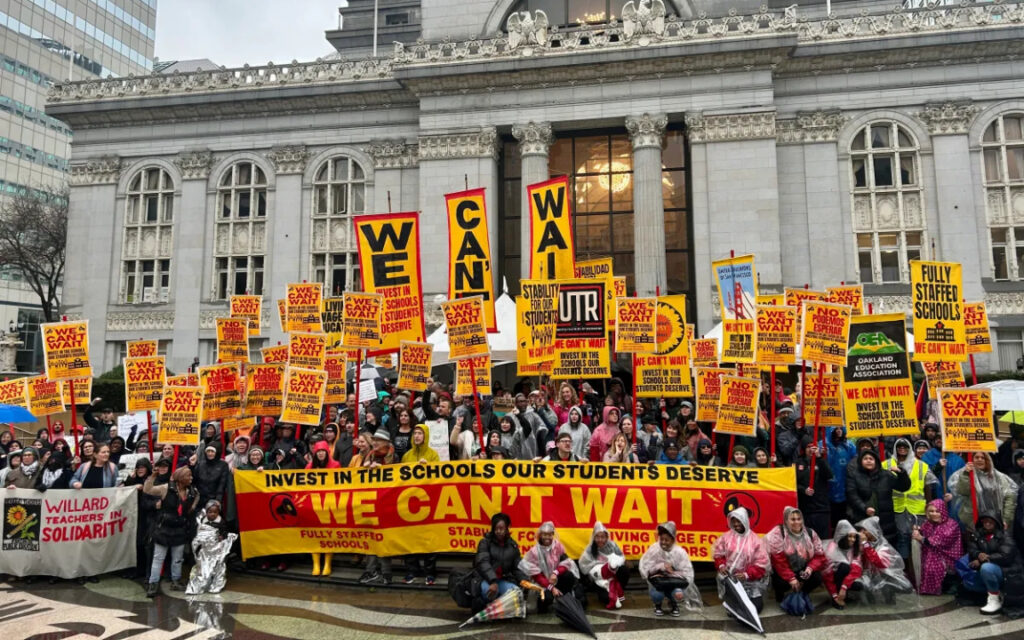
Los Angeles Teachers
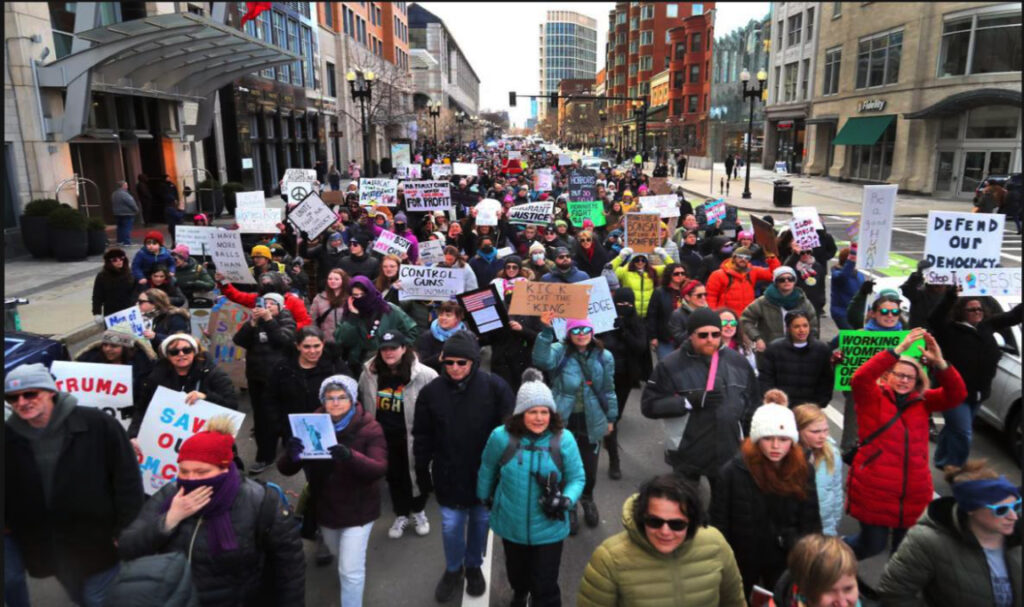
Santa Fe, New Mexico, Teachers and Students

Boston Women

International Women’s Day
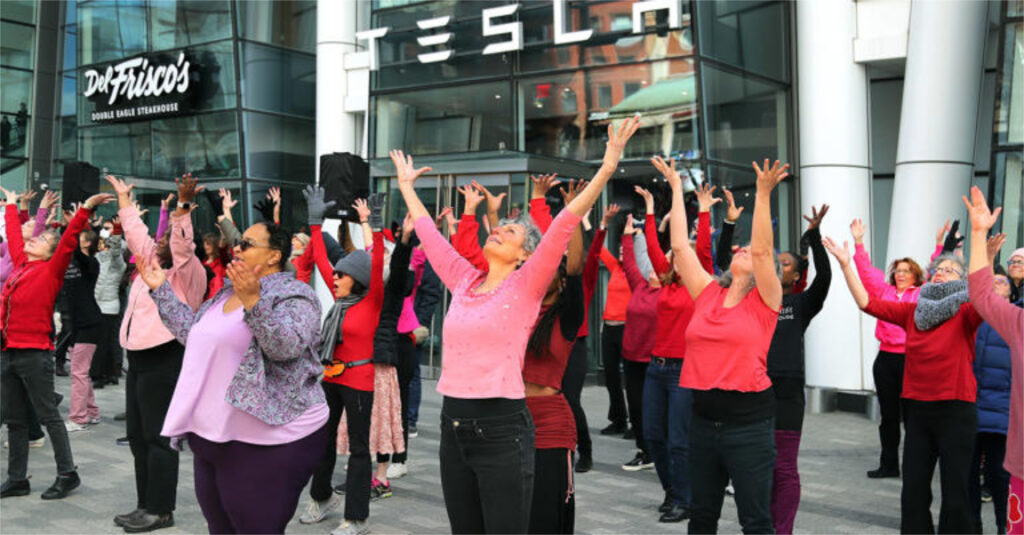
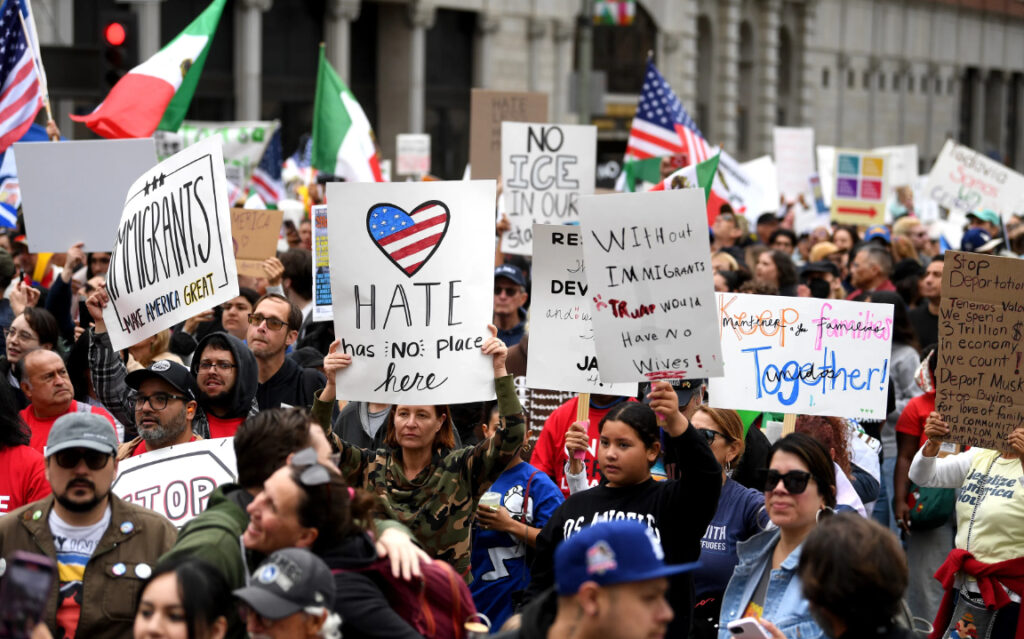

Sanders / AOC Rally in Denver

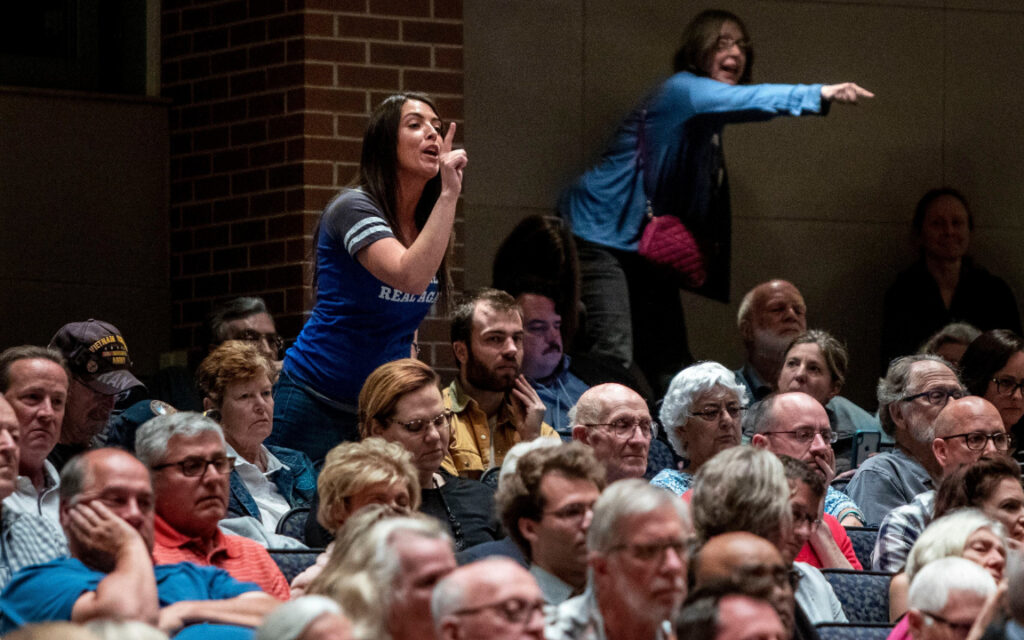
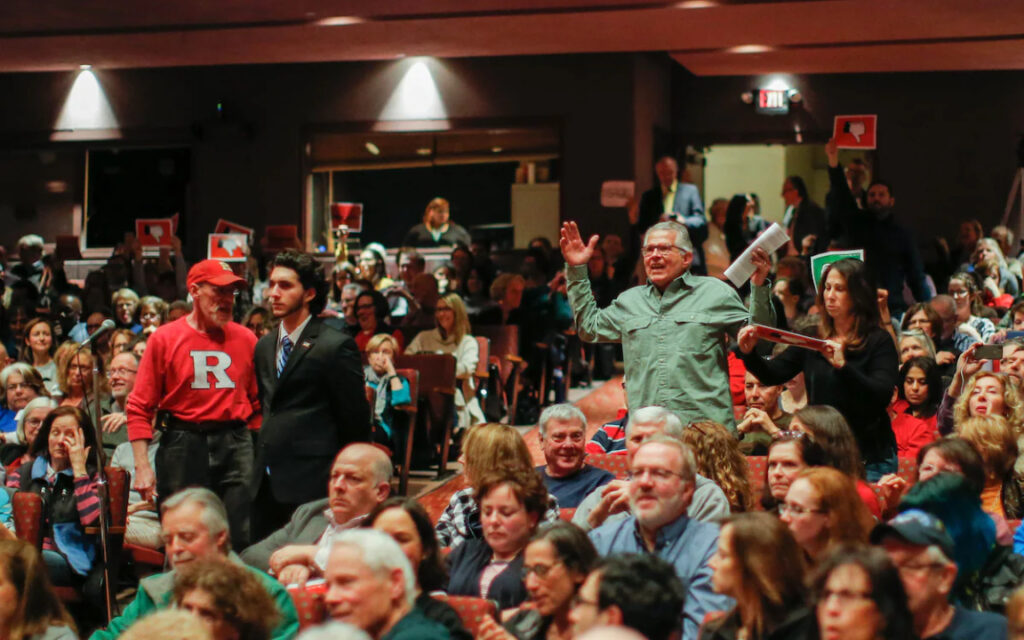
What Are Trump & Musk Up To?

While I have seen many discussions, mostly by liberals and social democrats, about the causes and effects of Trump’s realignment of U.S. “foreign policy,” or global relations, I have not seen any discussion (by anarchists or Marxists or whomever) about the class dynamics behind this change. Most seem to accept that this is just a free-floating policy change by an eccentric president who is stupid and nutty. But that would not account for the anti-Ukraine sentiment among the right as well as a number of pundits and Deep Thinkers. There has to be more, some sort of fractional-class faction behind it. I can speculate myself but has anyone else any ideas or seen anyone considering the topic?
—Wayne
- Getting rid of regulations that get in the way of profits, especially the profits of mega corporations.
- Gutting environmental regulations that stand in way especially of oil, coal, construction, shipping, logging etc.
- Getting EU to drop or reduce its guard rails against AI, its antitrust penalties against US corporations (Apple, Google, etc.). This is one of the motivations behind Trump’s fanatical nationalist rhetoric and trade war bluster.
- Cutting taxes on wealth, corporate and private. That’s the motivation behind the cuts, real and rhetorical, to federal government spending. The well-being of the masses is hardly even an afterthought, so cutting or eliminating social welfare programs follows.
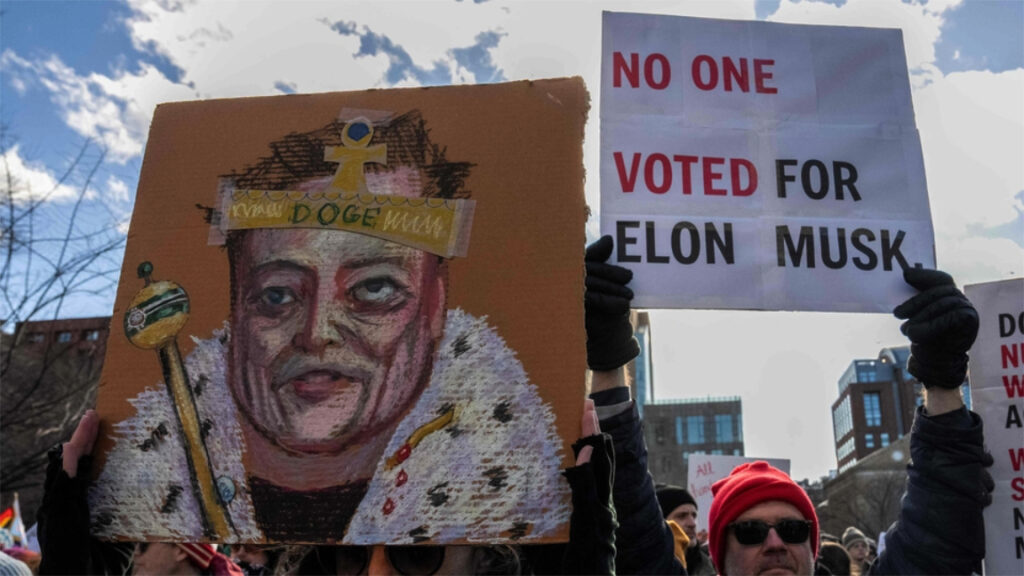
- Funneling cash and contracts to allies, friends, and family. Trump and cryptocurrency. David Sachs.
- Plans to replace FAA technology via contract to Musk’s Starlink. Starlink also in line for big rural Internet contract after a $42.5 billion Biden contract scrapped.
The fanatical MAGA nationalism, including the immigrant bashing and the tariff trade war mongering and the vulgar barbs at the Democrats (“stupid Biden”, “Pocahontas Warren”, etc.) are part of a conscious campaign to divide the country and harden his camp while distracting from his main profiteering goals, convincing common folks that they need to make economic sacrifices, and that their declining living standards and loss of essential services are all patriotism in the interests of the USA. This is one way an extreme right wing nationalist base may congeal.
- Kowtowing to Putin. Trump seems to be in awe of Putin. Why? Well, he aspires to be what he thinks Putin is.
NOTICE THAT TRUMP’S STYLE IS TO ACT LIKE HE IS MOVING FAST AND BREAKING THINGS, BUT MOSTLY HE IS MAKING FEARMONGERING ANNOUNCEMENTS FOR MORE THAN HE EXPECTS TO GET, AND THEN PUSHING UNTIL HE MEETS RESISTANCE. THIS HAS BEEN THE CASE WITH TARIFFS; IT HAS BEEN THE CASE WITH MUSK’S MINDLESS CUTS FIRST FOLLOWED BY RESTORING SOME POSITIONS; IT SEEMS TO BE WHAT’S GOING ON RIGHT NOW IN HIS DEALINGS WITH ZELENSKY.
NOTICE that deregulation, privatization, funneling value to capital, austerity cuts to public services all occurred for decades prior to Trump – Carter, Reagan, Clinton (Glass-Steagall gone etc.), Bush II, Obama (bank bailout). As did massive deportations. This is different – on steroids, a lot more explicitly divisive, fanatical nationalist rhetoric, turning away from traditional allies and towards Putin.
Several Silicon Valley tech bros believe that highly advanced tech weapons systems and surveillance can do much of the military’s job at a fraction of the cost. This is a factor behind the announcement of big cuts coming to defense spending, as well as funneling big and lucrative contracts to the techno billionaires and their companies.
—Jack
Kowtowing to Putin. Trump seems to be in awe of Putin. Why? Well, he aspires to be what he thinks Putin is. Tough, smart, all- powerful strongman.
Again, this explains his personal attraction to Putin (also Xi, Kim, MSB, etc.) In his insecurity he wants to imagine himself as a starker (Yiddish) and so hangs around the tough guys. But there must be more than this, broader state and economic reasons for the turn away from NATO.
—Wayne
While Jack’s draft focused on domestic issues, he did bring up Putin, and Wayne commented further, continuing to ask the ‘why?’
Here’s my speculation:
- Trump may imagine Russia to be more powerful than it is.
- Trump may see a new world order that is led by Putin and Trump (much as the U.S. is currently led by Musk and Trump). This new world order sees its natural allies as other authoritarian/authoritarian states.
- MOST IMPORTANTLY, Trump sees Russia as a Christian Nationalist nation (he is probably unaware that it is a little more complicated than this—but it is nevertheless fundamentally true). In addition to being a crook, a scam artist and a dope, I think Christian Nationalism is fundamental to Trump’s identify (as I believe it is to a significant portion of the MAGA base.) This expresses itself loudly via who Trump targets in the U.S., and who he cozies up to internationally. As with the WWII alliance between Nazi Germany and militaristic Japan, some Asians get a pass.
—Rod
My initial reaction to Rod’s points: yes, to the second point, which I think is important; a qualified yes on the third point. I will take a pass on his first point.
—Jack
Thank you, Jack & Rod. Things to consider. BTW, I suspect Trump wants a three-way world order, dominated by the US, Russia, and China.
—Wayne
Wayne,
The point on Putin was a note to myself to add something explanatory. It’s clearly not that now. But as to underlying reasons, as I started saying in the draft but didn’t really elaborate:
One factor behind Trump’s (and Vance’s) EU bashing is the desire to free Google, Apple, Meta, Tesla et al from EU regulations—multi-billion-dollar fines to the tech giants for antitrust violations with threats of forcing them to break up; EU protective guidelines against the danger from runaway AI. Silicon Valley wants to be rid of these vexing priests.

Another factor is the need to use nationalism—over-the-top, fanatical nationalism—as a way to congeal and hold a mass base, to convince people that the loss of jobs, income, the higher cost of staples, the elimination of essential services are all serving the higher cause of the country and will sooner or later lead to better times. Hence the scapegoating of immigrants, women, gays, transgender, Mexicans, the EU, etc. Because telling people that they are sacrificing to enable cutting taxes on corporations and the rich won’t cut it.
I think that mercantilism, actually Trump’s transactionalism, fits well together with the fanatical nationalism. It projects a zero-sum world—winners and losers. Combine this with might makes right and you go a fair way to understanding what’s going on.
Finally, Trump is pushing hard against a reaction against extreme identity politics, which the far right here and abroad identifies as the cause of everything that’s wrong with the world. And since there’s a lot that’s gone wrong for a lot of people from neoliberalism, this has struck a responsive chord. This and other factors need elaboration—including the love affair of Vance with the AfD, Bannon with Orban and Salvini and the AfD, Musk with Tommy Robinson, etc.
—Jack
It’s pretty clear that Trump thrives on chaos. It’s worth looking at which sectors of capital are hurt most and which least by his erratic policies. Here are a few thoughts on this, not meant to be comprehensive.
Despite all his bluster about manufacturing, for one big example, decimating supply chains is surely going to harm much of domestic industry in the short and medium terms (and who can plan long term under erratic Trump.)
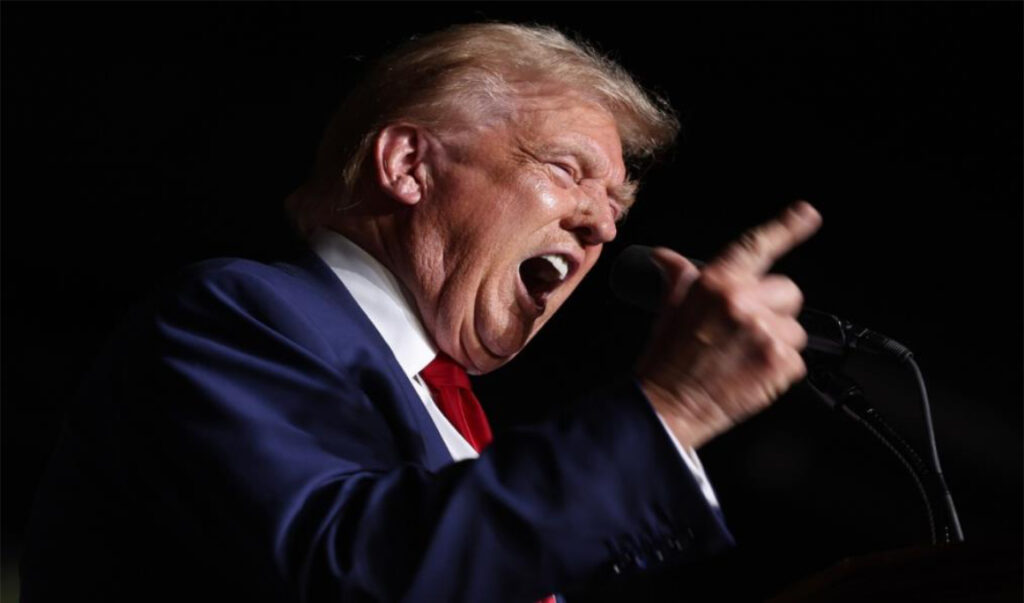
For another example, much of U.S. agriculture would be hurt if he imposed the tariffs he threatens. Most of the financial sector, has to be worried—if not outright terrified—by the imposed uncertainty. Importers and exporters can’t plan more than a few hours ahead.
Then there are sectors which will take advantage of the wholesale deregulation. This includes many of the biggest Silicon Valley players (Musk’s Starlink appears about to replace the FAA without competitive bidding or oversight); AI safety regulations are scrapped; au revoir to antitrust action against Google, Meta et al; the cryptocurrency casino vultures, maybe oil and gas companies (who will try to take advantage of the phony “national energy emergency” declaration and the laying open of the Arctic).

And amid chaos there are the naked rip-offs. As I said in earlier emails, Trump’s view is zero sum: there are winners and losers; winners take what the losers lose, with score kept by financial gain (and whenever possible to boast while humiliating the victim.) So, it’s a mistake to ignore that personal greed and acquisition has always been a driving motivation of Trump’s, using lying, intimidation, and thinly veiled threats of violence to get what he wants. Might makes right, gangster style. Think kleptocrats, crony capitalism.
With that in mind, it’s worth mentioning, just in case anyone missed it, that Trump and friends are carrying out a huge robbery in broad daylight. For one, let’s look at cryptocurrency, a giant scam in itself, resembling a Ponzi scheme. Trump and his wife each recently released their own meme coins, and Elon Musk is a big crypto investor but that’s just the surface. On Sunday, Trump announced that the Federal Reserve would backstop five leading cryptocurrencies. Trump’s crypto and AI czar, David Sacks, just happens to be heavily invested in all five.
Also on Sunday, Trump gave his thumbs up to criminal money laundering by getting rid of the requirement that U.S. shell companies had to disclose their underlying ownership. A few weeks earlier, Trump shuttered the Justice Department’s anti kleptocracy initiative that, among other things, impounded the mega yachts of Russian oligarchs. (Trump’s mega condo buildings have long been considered money laundering sites, especially for Russian oligarchs—for example, Russian passport holders have invested about $100 million in Trump’s Florida towers; many of the units are owned anonymously.)
It’s highway robbery. In broad daylight. Reminiscent of Trump’s infamous remark that he could shoot someone in broad daylight on Fifth Avenue and get away with it.
—Jack
Thank you for this analysis. It hangs together, though it raises the question as to whether the politics of it all matter at all. That is to say, are the politics merely designed to create openings to and cover for theft, or are they a parallel track in their own right?
I’d be interested in yours, and other people’s thoughts.
—Rod
A few thoughts:
I think that the extreme nationalist politics are an essential part of Trump’s approach, as they have been for so many megalomaniacal authoritarians. Trump believes in the primacy of force and forcefulness; he believes that he’s special and—perhaps therefore—his greatness and specialness is underscored by the greatness, specialness and strength of the US as compared to other, weaker and therefore contemptible countries. Thus, MAGA. Thus, demeaning the “other”. This applies globally; it also applies to the extreme hostility and contempt for the “others” domestically. Hence immigrant bashing, racism, misogyny, …
Of course, this nationalist movement serves a practical purpose—in helping him to get elected; in intimidating opponents; in getting his base to go along with cutting corporate taxes while convincing everyday people that decline in their income, purchasing power, medical care, housing etc. are actually patriotic acts for the good of the country and necessary to make America great again and to repel the threats from the “others” from abroad and from the “others” at home. And they too are special people when compared to the scapegoats.
—Jack
P.S. The perceived failure of neoliberalism—a reaction against deindustrialization, against the gross overreach of identity politics (e.g., defunding the police); the identification of the Democrats with the elite and with state bureaucratic waste and harassment; a desire to make life better by making it simpler. These and other real sources of dissatisfaction with top-down control and with complexity were recognized and tapped by people like Bannon and seized upon by Trump.
This is the sort of thing I am looking for, from Dave Finkel in an article in Solidarity.
“Russia’s three-year imperialist and annexationist invasion of Ukraine has been a strategic failure, not a victory. Despite the brutal impact on Ukraine and its people, Putin’s goals of erasing Ukraine’s independent existence and imposing a puppet regime are nowhere near achieved, and the massive military casualties Russia suffers are not sustainable much longer (even if Ukraine’s also may not be).
“In that context, what conceivable sense can there be in Trump throwing Putin a lifeline and sabotaging Ukraine’s struggle for survival? And why is Israel reportedly lobbying the United States to urge Syria to let Russia keep its major naval and air bases in post-Assad Syria, which has caught the attention of a Ukrainian news organization?
“On the face of it, Trump and the MAGA/alt-right part of his base actually favor Putin’s Russia and the same far-right parties in Europe that Putin supports and promotes. There is plenty of truth, and menace, in this, but there’s more to it beyond authoritarian ideological affinity.
“In the strategic runup to confrontation with China, disrupting the Russia-China so-called “partnership without limits,” as Chinese president Xi put it, is a vital U.S. imperial goal. Imposing a rotten and false “peace” on Ukraine and Europe could solidify a new U.S.- Russia partnership, although whether it would survive the Trump presidential era is an open question.”
—Wayne
But Wayne, just yesterday you wrote that you thought it likely that the US, Russia and China would divide up world dominance. Dave Finkel is going elsewhere, isn’t he?
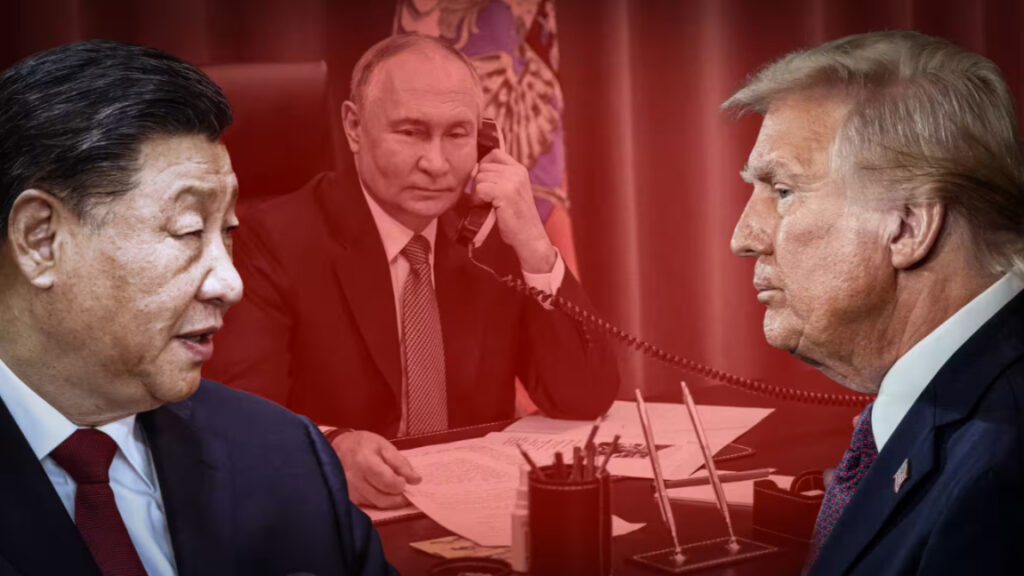
So, a few quick remarks:
First of all, it’s not clear to me that, between Trump and Putin, which one is the dog and which the tail.
Second, and related to the first, Trump would have a hard time cementing an alliance with Putin against China. Putin and Xi are much better at playing both ends against the middle.
So, for one thing, I don’t rule out Trump trying to abandon support for Taiwan and cozying up to Xi. It’s not hard to envision possible scenarios. For example, Trump may ask Taiwan to pay for the U.S. naval presence in the region going back decades and demanding hundreds of billions of dollars as “reimbursement.” Plus, any of a variety of possible demands about Taiwan’s world leading semiconductor industry.
I don’t want to put down what Dave Finkel wrote. It was a short email. But I hope that you are looking for more than that.
—Jack
I’m just looking at possibilities. There has to be more than Trump’s psychopathology. (Not denying that he’s a nut, who was good at running for election, not so good at governing.) I do think that Trump sees the world—or wants the world to be—a three-way division of great powers: the US, Russia, and China. In this division of the big boys, he may want the US and Russia to ally against China. How realistic this is, is another matter, of course. But it may make some sort of global realpolitik to a section of the capitalist class and its establishment, including your point about there being reasons for part of that ruling elite to want to weaken Europe.
—Wayne
One thing to consider regarding Trump’s approach: He sees the late nineteenth century as a model both domestically and internationally. He admires the Gilded Age—the powerful winners at home (the Robber Barons et al) and globally (the imperialist colonial powers who claimed lands and appropriated their natural resources. He sees this as a model for his winner take all by force approach. In keeping with this, he sees himself as above the law and has huge admiration for those he sees as masters of such (Napoleon; Andrew Jackson; Putin, …). Several have compared this to the attitude of Athenian envoys in the Peloponnesian War, as reported by Thucydides: “The strong will do what they will, and the weak suffer what they must.”
He sees Putin as strong, Ukraine (and therefore Zelensky) as weak. He sees Israel as strong, the Palestinians as weak. He sees Denmark as weak, Panama as weak, etc. So, he demands Ukraine’s natural resources (which he would rather share with Putin, so demand that Ukraine accept a humiliating peace deal); he demands Gaza; he demands Greenland, the Panama Canal, etc. Might makes right, zero sum, winner takes all from the losers. Contempt for the weak, obsequious to the strong. Highway robbery in broad daylight. This applies to his foreign policy as well as to his domestic policy.
—Jack
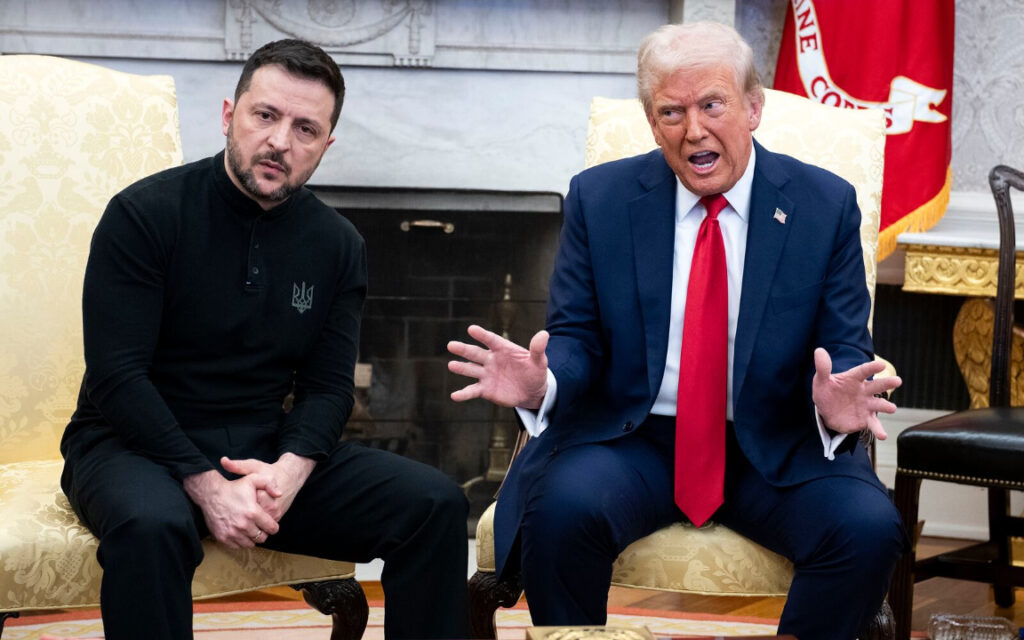
Exactly so. This contradicts those who thought Trump really was an isolationist and are then surprised when he comes out as another imperialist.
—Wayne
While Trump may admire Napoleon, Putin, and other extreme authoritarians, and want the U.S. to be one of three world ‘big boys’, his view at least v. China is no flash in the pan. U.S. policy for ‘containing’ China has been around since the Clinton administration.
—Bill
Certainly. I think that there were beginnings of this under Carter, and certainly under Bush the First. In fact, I think it was one of the many sub currents in Nixon/Kissinger/Chou ping pong diplomacy. Which does not mean that Trump won’t abandon Taiwan. I am not saying that will happen, given that (for example) Peter Navarro still has his confidence on China. But it would be a mistake to rule it out.
It would also be a mistake to rule out an orientation towards a—at least short term—attempt at a global division into spheres of influence with the US and China as the major players–and maybe Russia too, given geopolitics and Trump’s current and past behavior. Do I think this will hold long term? No. But do I rule it out short term? No again.
Bannon and Vance—who aren’t really allies—both want to scrap the Atlantic Alliance. Trump professes to prefer Putin to Zelensky—he thinks Zelensky is a dictator and a warmonger, while Putin is a reasonable guy who really wants a just peace and is easier to deal with (even in 2018, in his first term, Trump announced that he believed Putin and not the FBI.) There’s a lesson here: policies can shift and may.
—Jack


